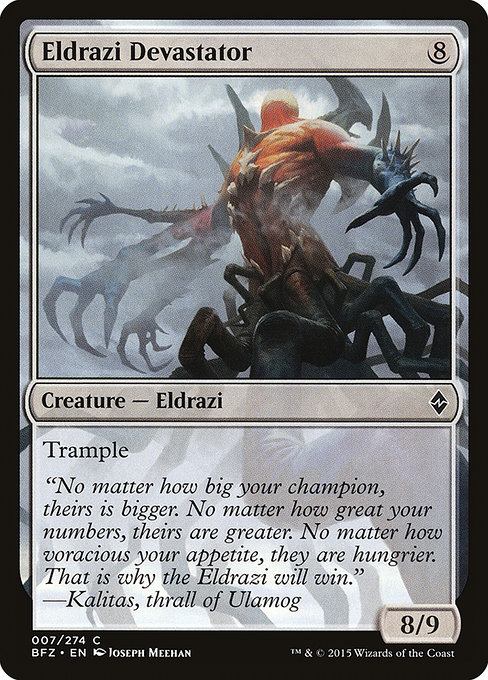
Image courtesy of Scryfall.com
Cultural symbolism behind its creature type
In the tapestry of Magic: The Gathering, some creature types read like folklore, and others read like an existential dare. Eldrazi, the colorless leviathans from the Blind Eternities, sit squarely in the latter camp. They are not defined by a single color or culture; they are defined by appetite, scale, and a mindless hunger that ignores plans, parries, and pleas. When you encounter Eldrazi in Battle for Zendikar’s era, you’re looking at a narrative tension that transcends individual spells: the idea that some forces breach every boundary we pretend to keep—color, identity, even sanity. 🧙♂️⚔️ Their very existence invites a cultural meditation on entropy, on the consequences of unrestrained expansion, and on what happens when entities so vast become the floor beneath which heroes once stood. Fire, ice, wisdom, and cunning all tremble before a force that devours whole continents, leaving only the whisper of “what comes next?” in its wake. 🔥💎
Colorlessness as a cultural mirror
MTG’s color wheel is a map of values: invention and curiosity, ambition and discipline, chaos and order. The Eldrazi don’t announce themselves with a signature color; they announce themselves with absence—an empty palette that can redraw the battlefield in invisible ink. That colorless identity acts as a cultural mirror for players: when a card costs eight mana and still delivers relentless pressure, it feels like the universe has thrown off its colorful constraints and decided to bulldoze its way through the rules. In this sense, Eldrazi Devastator embodies a timeless trope—the unstoppable force that refuses to negotiate. Its trample ability isn’t merely a stat line; it’s a metaphor for how some pressures, once unleashed, push everything else out of the way. 🎨🎲
Art, design language, and the mythic scale
Joseph Meehan’s illustration for this creature leans into the mythic grotesque: a towering, amorphous figure pressed between stone and sky, its mass dwarfs the horizon, and its jagged silhouettes cut through the glow of Zendikar’s air. The 8/9 body—paired with the eight-mana cost—reads like a statement piece: size matters not just in power, but in the storytelling of a game where time is a resource and every draw could tilt the cosmos. The design language of BFZ—vast horizons, horizon-defying adversaries, and the sense that reality is thinning—pushes players to feel that they’re facing something older and bigger than heroics alone can manage. In that sense, the Eldrazi are artful nods to Lovecraftian resonance: not simply monsters, but existential questions etched into creature form. 🧙♂️🖼️
“No matter how big your champion, theirs is bigger. No matter how great your numbers, theirs are greater. No matter how voracious your appetite, they are hungrier. That is why the Eldrazi will win.” —Kalitas, thrall of Ulamog
Flavor, lore, and the mythic scale
This flavor text anchors the conversation in the lore of Zendikar. Kalitas’s perspective—utterly confident in his own power yet humbled before the Eldrazi’s appetite—frames the topic as a clash of scales. In the broader mythos, the Eldrazi are not merely beasts; they are forces that redefine the planet they touch. The creature type serves as a cultural signal: when you tap an Eldrazi, you’re not just casting a spell, you’re inviting a story about resilience, warning, and the fragility of civilizations that think they’ve outgrown the need for vigilance. It’s a reminder that some chapters in a card game’s saga are written in the language of dread and awe, not just victory. 🧙♂️⚔️
Gameplay, collector culture, and the wider impact
From a gameplay standpoint, Eldrazi Devastator is a textbook embodiment of “big threat, big payoff.” An eight-mana investment yields a formidable body with trample, capable of punching through defenses that a mere handful of smaller creatures couldn’t bother. On Battle for Zendikar’s battlefield, you felt the gravity of a world where land and sky alike were threatened by something ancient and universal. Modern players who enjoy colorless ramp and Eldrazi-styled control decks can still feel that DNA in contemporary formats—the hunger of the tribe that values raw power, the artful inevitability of a well-timed attack, and the thrill of watching a plan accelerate toward a game-altering moment. And for collectors, the common version with its foil option—paired with a flavorful piece of lore—offers a reminder that uniqueness isn’t only about rarity; it’s about how a card’s story resonates with a community that has shared the experience of a towering threat. 💎🧙♂️
- The Eldrazi creature type acts as a cultural axis—crossing color lines to signify universal danger. 🧭
- Flavor text and lore deepen the sense of scale, turning a single card into a gateway to a broader mythos. 📜
- Visual design and mana cost reinforce the thematic heft of an unstoppable force. 🎨
- In multiplayer formats, such a card invites strategic alignment: ramp, removal, and timely threats all collide at the same moment. ⚔️
For players looking to set the stage for a long, storied session, you’ll appreciate the everyday practicality of a well-made surface. If you’re prioritizing comfort and control during those extended tabletop nights, consider this Non-slip Gaming Mouse Pad—a small but meaningful upgrade to your gaming ritual. It’s a friendly companion to the lore-heavy spectacles of the Eldrazi, helping you keep your focus while the cosmos unfolds around your board. 🧙♂️🔥